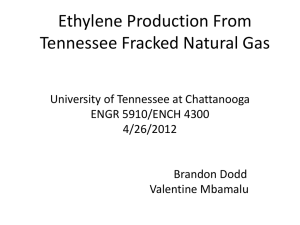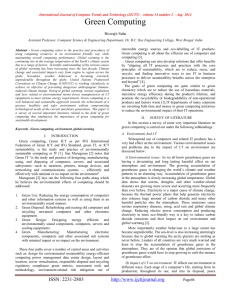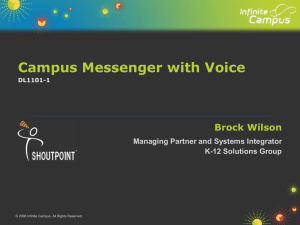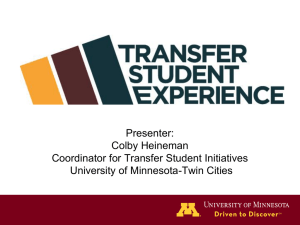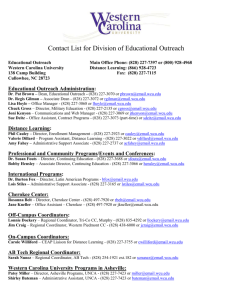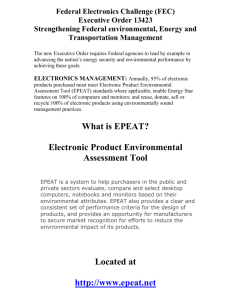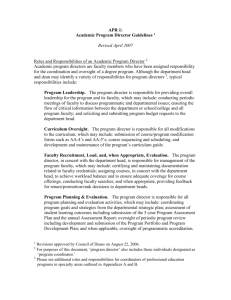Green I.T. at West Chester University
advertisement
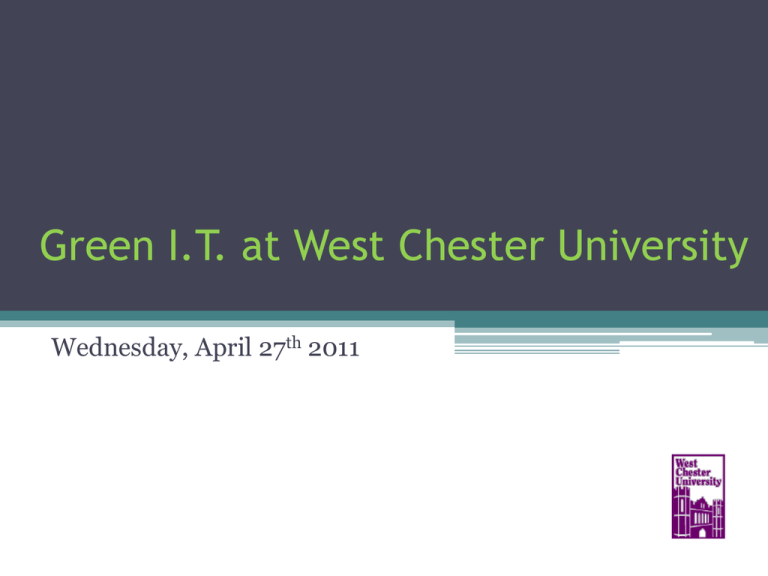
Green I.T. at West Chester University Wednesday, April 27th 2011 Goals of Becoming Green 1. Reducing wasted printing resources 2. Utilizing energy efficient desktop and server computer equipment 3. Building more energy efficient Data Centers 4. Building more energy efficient campus networks Reducing the Need to Print • Expansion of University Web Pages ▫ WCU Website is a vital source of information for current and prospective students, parents, alumni, faculty, staff and campus community – electronic content decreases need for printed distribution ▫ Campus events and announcements advertised and promoted on WCU Homepage ▫ Budget Updates posted on-line ▫ Undergraduate/Graduate course catalogs available on-line ▫ Over 50 web forms with electronic delivery available on-line ▫ 200+ clients have ability to maintain their departmental websites, ensuring availability of the most accurate and up-to-date information Reducing the Need to Print • Student Learning Management System (LMS) provides for storage of class materials online and promotes electronic distribution to students • Digital Signage promotes electronic notification of news and campus event ▫ 18 displays currently deployed in 12 campus buildings ▫ Upcoming deployment of 5 displays in 1 current and 3 additional campus buildings • Microsoft Exchange 2010 – Increased Storage Capacity ▫ Faculty / Staff have 6x more e-mail storage capacity: 300MB → 2GB (2048MB) ▫ Students have 19x more e-mail storage capacity: 100MB → 2GB Reducing the Amount We Print • Academic Computing Center (ACC) one of the first locations on campus to implement paper recycling • Combined effort by ACC, SGA and Library to make students more conscientious of printing what they actually need Reducing the Amount We Print • 10 year “Paper Cut Initiative” to eliminate the tremendous amount of wasted resources ▫ 2002 student printing limited to 75 pages per day ▫ Fall 2009 student printing changed to 300 pages per week ▫ Spring 2010 Duplex Option for 2-sided printing added in Anderson Hall computer labs ▫ Fall 2010 student printing changed to 125 sheets per week; Duplex Option doubles effective limit to 250 pages Energy Efficient Equipment • All campus desktops, notebooks and monitors meet EPEAT standards • Electronic Product Environmental Assessment Tool (EPEAT) • WCU/PASSHE has standardized on Lenovo desktop and notebook computers • Colleges and universities spend close to $2 billion each year on energy. Adopting a strategic approach to energy management can lower energy bills by 30% *1 *1 Information from Lenovo website: http://shop.lenovo.com/us/epeat-forhigher-education.shtml Energy Efficient Equipment • Compared to conventional products, purchasing EPEAT products: *1 ▫ Saves 13.7 billion kilowatt-hours of electricity, enough to power 1.2 million U.S. homes for a year. ▫ Saves 24.4 million metric tons of materials, equivalent to the weight of 189 million refrigerators. ▫ Prevents release of 56.5 million metric tons of air pollution, including 1.07 million metric tons of global warming gases—the equivalent of removing 852,000 cars from the road for a year. ▫ Prevents release of 118,000 metric tons of water pollution. ▫ Reduces toxic material use by 1,070 metric tons, including enough mercury to fill 157,000 household fever thermometers. ▫ Avoids the disposal of 41,100 metric tons of hazardous waste *1 Information from Lenovo website: http://shop.lenovo.com/us/epeat-for-highereducation.shtml Energy Efficient Equipment • Lenovo Product Registrations with EPEAT *2 *2 Information from EPEAT website: http://www.epeat.net/CompanyDetail.aspx?CompanyID=37 Energy Efficient Equipment • HP Sever Computers used at WCU meet EPA ENERGY STAR ratings * ▫ ENERGY STAR is a voluntary energy efficiency program sponsored by the U.S. Environmental Protection Agency ▫ ENERTY STAR qualified products use less energy and reduce greenhouse gas emissions by meeting strict energy efficiency guidelines set by the U.S. EPA and DOE ▫ Computer servers that earn the ENERGY STAR rating are 30 percent more energy efficient than standard servers *According to HP documentation Energy Efficient Equipment • HP Sever Computers used at WCU meet EPA ENERGY STAR ratings * ▫ WCU’s HP servers come embedded with energy efficient features based on HP Thermal Logic technology which earn the ENERGY STAR rating ▫ ENERGY STAR computer servers include efficient power supplies that have smaller conversion losses and generate less waste heat, reducing the need for excess air conditioning in the Data Center which reduces our carbon footprint *According to HP documentation Energy Efficient Equipment • New Allegheny Hall Data Center, opened in 2009, was designed for energy efficiency, using cold-aisle cooling, blade server and server virtualization technologies that reduced energy consumption by 50% compared to the old E.O. Bull Data Center • E.O. Bull Data Center is currently being renovated and redesigned for energy efficiency utilizing the same technology deployed in the Allegheny Hall Data Center • Two newest residence halls, Allegheny and Brandywine, are completely wireless to reduce energy consumption in the data network closets • All future HRI residence halls will be wireless *3 *3 See WCU website News and Events: http://www.wcupa.edu/pr/2010_2.3Arubawireless.asp Energy Efficient Data Centers • Building ▫ New Alg Data Center 40% reduction in data center floor space • UPS Power Draw ▫ Bull Data Center: 40 kVA ▫ Alg Data Center: 20 kVA • 50% energy reduction; same capacity in half the space Energy Efficient Data Centers • Cooling ▫ Bull Data Center: Perimeter Cooling ▫ Alg Data Center: Hot Aisle / Cold Aisle Cooling • Blade Servers ▫ Blade Server Enclosures provide power, cooling and network infrastructure ▫ Blade Servers deliver the same benefits of rack servers but in a smaller, more power-efficient form factor Energy Efficient Data Centers • Server Virtualization ▫ A single blade server hosts multiple applications, each one running on its own virtual server ▫ Hypervisor installs on top of the physical server allowing the equipment resources (processor, memory, I/O bus) to be shared by the multiple virtual hosts ▫ Sharing the physical server resources provides for more efficient resource utilization, reducing the number of server computers in the data center Energy Efficient Data Centers • Storage Area Network (SAN) ▫ Shared data storage environment used by entire virtualized server environment ▫ Sharing the data storage resources provides for more efficient disk utilization, reducing the number of disk drives in the data center Energy Efficient Network Closets • Forty percent of wired LAN ports are typically underutilized or not used at all • Most new students have Wi-Fi enabled computers, netbooks, smartphones and media players • Installing wireless networks in new residence halls significantly reduces build-out costs, electricity consumption and cooling in Network Closets for the LAN switches, and on-going equipment maintenance costs Energy Efficient Network Closets Going wireless will: • Save roughly $250,000 in network equipment acquisition costs for each new residence hall • Lower carbon footprint for the building by 25 metric tons per year due to reduced cooling and power requirements for LAN equipment • Create additional savings on copper cabling installation, reducing the demand for products that are not always made with the most environmentally friendly materials


